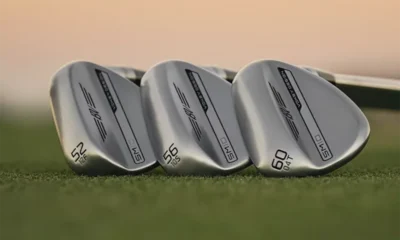-
-
by
Mark Perry
Key Points:
- Dimples on golf balls play a pivotal role in reducing aerodynamic drag.
- The design and pattern of these dimples can significantly influence ball flight and distance.
- Advances in dimple technology continue to revolutionize the golfing experience.
A Brief Dive into Golf Ball History
The game of golf boasts a rich tapestry of history and evolution. At the heart of this storied journey is the golf ball. From its rudimentary beginnings as wooden spheres to the feather-filled leather pouches of the ‘featherie’, the golf ball has witnessed numerous transformations. However, the introduction of dimples on its surface stands out as one of the most groundbreaking developments.
Unlocking Golf Ball Aerodynamics
Understanding the flight of a golf ball means delving into the intricate world of aerodynamics. When a golfer swings, the force exerted on the ball propels it through the air. This motion, while seemingly simple, is influenced by a myriad of factors. The ball’s speed, spin, and the angle of its trajectory all play crucial roles in determining its final resting place on the green.
As the ball sails through the air, it encounters resistance or ‘drag’. This resistance can drastically affect the ball’s performance. Enter the fascinating science of golf ball aerodynamics.
Dimples: The Secret Weapon Against Drag
The presence of dimples on a golf ball isn’t just an aesthetic choice. These small indentations serve a significant purpose: they combat aerodynamic drag. As the ball moves, the dimples generate turbulence around the ball’s surface. This turbulence, in turn, reduces the ‘wake’ or the zone of low pressure that forms behind the ball. A smaller wake translates to less drag, allowing the golf ball to travel further.
Comparing a smooth ball with a dimpled one highlights the dramatic difference. Without dimples, the ball would experience increased drag, making it drop from the sky sooner and limiting its distance.
Diving Deep into Dimple Design
Golf ball manufacturers don’t just randomly select a dimple pattern. A lot of science and research goes into determining the optimal design. The depth, size, and overall pattern of the dimples can significantly influence the ball’s performance.
Different designs cater to specific needs. For instance, larger dimples tend to produce a ball flight that’s lower and has a more penetrating trajectory, while smaller dimples can lead to a higher arc. The total number of dimples, which usually ranges between 300 and 500, also plays a part in the ball’s aerodynamic properties.
Manufacturers invest heavily in R&D, often using wind tunnels and advanced simulations to study airflow around the ball. This rigorous testing ensures that each golf ball produced offers the perfect balance of distance, accuracy, and control.
Harnessing the Benefits of Dimples
While the primary role of dimples is to reduce aerodynamic drag, their impact on the game of golf is multifaceted. For golfers, the benefits are tangible and game-changing.
Firstly, distance is a critical factor in golf. With the reduced drag provided by dimples, golfers can achieve greater distances with their shots. This advantage is particularly noticeable when comparing modern dimpled balls with their smooth-surfaced predecessors.
Secondly, the spin rate is crucial for golfers looking to control their shots, especially during approaches to the green or when maneuvering around hazards. Dimples aid in optimizing this spin. Depending on the dimple design, golfers can achieve a range of spins suitable for various shots, from high-arcing wedge shots to low-flying drives.
Lastly, dimples offer adaptability. Golf is a game of diverse conditions—windy days, humid environments, or even altitude changes. The science behind dimples ensures that golf balls perform consistently across these varying scenarios.
The Evolutionary Journey of Dimple Patterns
The journey from smooth golf balls to the meticulously designed dimpled marvels of today is a testament to human ingenuity and the relentless pursuit of perfection. Early golfers noticed that older, roughened balls seemed to fly farther than smooth, new ones. This observation was the genesis of the dimple innovation.
Over the years, dimple designs have evolved dramatically. From rudimentary, handcrafted dimples to the precision-engineered patterns we see today, the focus has always been on maximizing performance. Some of the earliest dimpled balls had a random assortment of indentations. However, as understanding of aerodynamics grew, so did the sophistication of these designs.
In the late 20th century, advancements in technology allowed for more rigorous testing and design iterations. Computational Fluid Dynamics (CFD), for instance, provided manufacturers with a tool to simulate and analyze the airflow around a moving golf ball, leading to even more optimized designs.
Today, golf ball companies continually innovate, experimenting with hexagonal dimples, asymmetric patterns, and even multi-depth dimples, all in the quest to produce the most efficient ball.
Gazing into the Future of Dimple Design
While the golf ball has come a long way, the journey of innovation is never-ending. With the advent of newer technologies and materials, the future of dimple design is brimming with possibilities.
Research is currently underway to study the effects of variable-depth dimples, where each dimple might have a different depth, tailored to optimize performance. There’s also exploration into ‘smart’ golf balls, equipped with micro-sensors, to provide real-time feedback on spin, speed, and trajectory.
Materials science is another frontier. The quest for the perfect golf ball material—one that offers durability while maintaining optimal aerodynamic properties—is ongoing. Combining this with the latest in dimple design could produce golf balls that redefine the boundaries of the game.
The Undeniable Impact of Dimples
Dimples, while small in stature, have had a colossal impact on the game of golf. They are a blend of art and science, history and innovation, tradition and technology. For any golfer, understanding the role of dimples is not just about appreciating the nuances of the game but also about harnessing their benefits to elevate their play. From the fairways of local clubs to the greens of major championships, dimples continue to shape the narratives and outcomes of golfing tales.
Mark Perry: Editor-in-Chief of Golf News Nation Mark Perry, with 15 years in sports journalism, is the latest addition to Golf News Nation, bringing deep experience despite only starting golf in 2021. His fresh love for the game complements his expertise in sports analysis, offering a novel perspective to golf journalism. Even as a new golfer, Mark's dedication to providing insightful, factual, and engaging content is unwavering. He adeptly blends respect for golf's traditions with an understanding of its evolving aspects. At Golf News Nation, he's become instrumental in nurturing a community for golfers of all levels. Mark's passion for the sport and commitment to its community enriches his writing, ensuring a broad appeal to all golf enthusiasts. EMAIL: mark.perry@golfnewsnation.com Quote from Mark Perry "Despite my recent introduction to golf, my years in sports journalism allow me to blend a fresh enthusiasm with deep analytical insight, enriching the golfing narrative for enthusiasts at every level." ""










